Solar-Powered Trike
A guy named Chris sent this image and caption to Makezine. Looks like the solar panel flips back so you can drive it, though it must be sensitive to wind gusts.

“I just took this pic as I was walking down the street here in Palo Alto. This Maker has built an electric 3-wheel transport device, and he/she is charging it as it sits parked in the street! I don’t know who it is….”
Public Donations Box in Iran
Streetologist Jan Chipcase explores far flung places for patterns of vernacular street use. His blog is always rewarding. Recently he noticed public charitable donation boxes around the city of Tehran, Iran. Presumably folks put in their loose change.
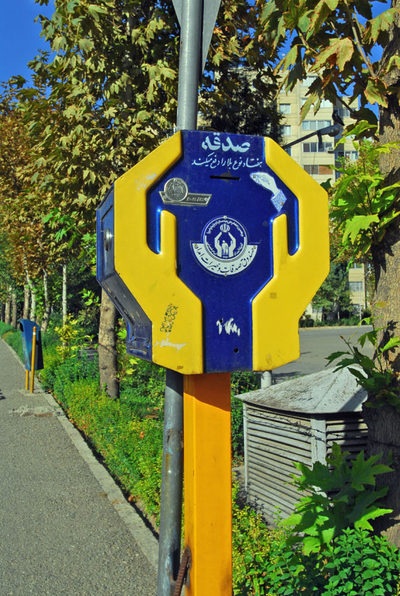
Hands and Feet Quad Bike and Bent Trike
Bikes are pretty easy and very rewarding to modify on the street. Here’s two very invention street modifications from Australia. They were found by Wade Hatler. He writes on his travelog: “I took off for a six-month bicycle tour two years ago and never quite managed to go back home.” Along his travels on the backroads of Australia he spied these two remarkable bikes.
“Why would someone build a homemade trike you ask? Well, because trikes have some compelling advantages, but commercially built trikes are pretty expensive. Someone with some skill in the machine shop can take a couple of old bicycles and make a nice stable, comfortable commuting vehicle with practically zero expense. The one [below] here has an actual office chair as the seat. You can see he hauls his daughter around on the trike, and life is good. Front wheels are simply the front steering assembly and part of the frame from a diamond frame bicycle. A crossbar hooks them together, and to the frame that holds the foot cranks and pedals. A small tie-rod connects the front two tires together, and steering is just a chunk of the original handlebars. You don’t get a blisteringly fast performing trike with Ackerman steering in this fashion, but you can get a good, solid, dependable, environmentally friendly vehicle for just about free.”
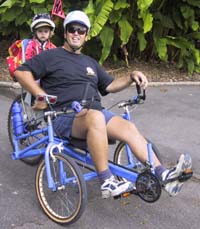
“This invention [below] is called the BiQuadly. It’s a four wheel, fully independent suspension, two wheel drive, multi-speed rig that’s powered by both the arms and the feet. I’ve never seen anything quite like it. It’s all a handmade prototype: Basically, you power the bike by cranking the pedals, which go through a conventional bike’s derailer to a jackshaft, which then goes back to each of the rear wheels. The two hand levers you see move in both the back to front and the left to right planes. In the back to front direction, they hook to a crankshaft. Once you get going, you can crank back and forth on the hand levers, and it applies power from your arms onto the pedals to assist your legs. In the left to right direction, the handles are hooked to the steering, and they make the front tires turn to steer.”
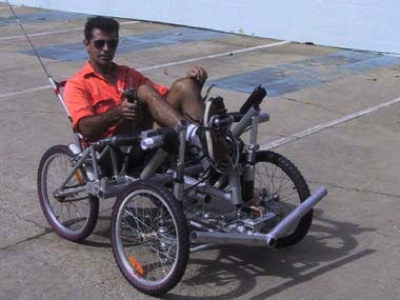
.
Homemade Landsailer
I don’t know much about this contraption, other than what the label at this windsailing website says: Homemade Landsailer. Looks cool though. Tell me if you know more.
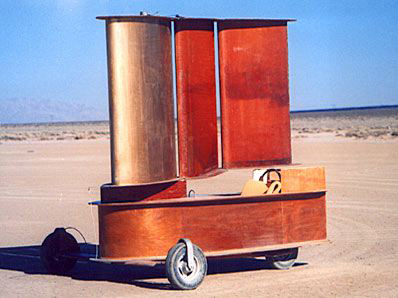
Backyard Pulse Jets
If there ever was a technology that calls out for street use, it is a jet engine. There is a small subculture of jet hackers. Among them is New Zealander Bruce Simpson who runs a cool website of his experiments. He tells how he got started:

When I first started tinkering with pulsejet engine technology in 1999, I realized that there was huge potential for improving these devices. Although deceptively simple in construction, their design had changed little in the 55 years since the end of WW2, when they were rapidly replaced by the now common turbojet. The opportunity to apply 21st century materials and knowledge to the task of improving a design still mired in the 1950’s was too great to resist — so I set about developing a range of engines, each incremental better than the last.

In true enthusiast street use spirit Simpson tells you how to make one yourself. He sells a book on DVD with instructions.

“A step-by step video shows you how to build this pulsejet for around $20 using just regular hand-
tools. That’s right, no welder or lathe is required.”
English Owner-Built Weapons
This summer (June 2006) the British declared it “National Knife Amnesty.” The idea was that common folk were to turn in their illegal knives and other weapons with no penalty. Amazing quite a few did — though no doubt most did not.

According to this report from Staffordshire Police website, “These weapons were only made for the purpose of fear and intimidation with the potential of inflicting serious injury, even death – there would be no other reason for their use.” said Sgt Jim Mills at the force’s crime reduction unit. “We are pleased that the owners’ have been responsible and handed them in. We would urge anyone who has home-made weapons to take the same route and surrender them at one of the designated police stations.” Tackling knife culture is paramount to the safety of our communities. People who carry bladed weapons run the risk of that weapon being used on them, or inflicting serious injury on others. It also carries a jail sentence of up to four years. The total number of weapons surrendered in Staffordshire during the amnesty, which has now been running for four weeks, has reached 1,420.”
But what is really surprising are the homemade weapons. Among those turned in are some pretty well-crafted pieces.

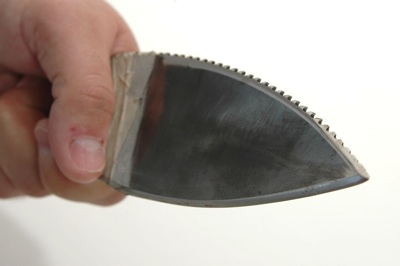
Readership Survey
Dear Friends of Street Use,
If you enjoy Street Use, please consider filling out this brief survey. Ads pay the bills to keep this site going and my friends at Federated Media (an ad network) would like to ensure the best match between potential advertisers and you, the reader. The better the match the better Street Use will thrive. Of course, FM only uses your aggregate information. Thank you.
(And yes, I promise to post more stuff.)
Homemade Wooden Skyscraper
This is almost more folk art than folk technology, but it is way extreme. Sent in by Michael Krakovskiy, it shows a 12-15 story skyscraper built of wood built by Nikolai Sutyagin in Archanglesk, Russia, shown here. Called a Izba, in smaller sizes it is a traditional Russian wooden dwelling.


Michael has more of the story based on his own research posted on his blog Deadprogrammer’s Cafe, but here’s a few paragraphs:
“When Perestroyka came about Nikolai Sutyagin used his money to start a lumber and construction business which brought him a substantial fortune. Now he needed a suitable residence. At first he planned on building a huge two story wooden house. Wooden structures are limited by law to two stories for fire safety reasons. At first he built a refrigerator sized wooden mock up. He liked the scale, but didn’t like the proportion of the roof. He decided to elongate it to achieve a more pleasing proportion. Then he started building working with his team like in the old times, but using the timber from his own company. When he was about done with the roof, he decided to build it up a little higher so that he could see the White Sea from the very top. Even though his building has two stories, the roof spans 11 more (some articles estimate the structure to have 12 stories, others – 13 and even 15).
The government and his neighbors hated Sutyagin’s masterpiece. Fire hazard or not, it stands in the middle of a rather poor village, yet it’s higher than the tallest cement building in the city of Archangelsk itself. The city government ordered the structure to be torn down, but the order was never realized as far as I know. But Sutyagin was accused by one of his employees (who stole $30,000 from Sutyagin) of beating him up and imprisoning him in a shed. True or not, Sutyagin got 4 years of prison. He was let out in 2 years. While he was away his company was looted like Baghdad after the war. Now he and his wife and daughter live in the unfinished skyscraper that he built.”
Monster Battery Electric Bike Mod
“Here’s an electric scooter I spotted on the beach in Santa Monica,” writes Brian Lauas. “Apparently modified for increased range with 2 monstrous car batteries strapped on. Transportation for the Post Apocalypse generation. Sweet.”

Snack Baggie Mobile Protection
Some mobile devices are not as waterproof as others. Alexander Rose has lost several Treos to mild moisture penetration — even from sweat in a pocket, or rain. His solution is a zip lock bag. It keeps water out and let’s sound and light in, so he can speak and hear normally through the plastic and punch in the keys. Here is what Rose says: “I am on my 3rd Treo in a little over a year (good thing I got replacement insurance!). It turns out they are ridiculously sensitive to water. Even hi humidity or sweat has made mine blank out. So now whenever there is risk of it getting wet (like rain) I put it in a snack sized ziplock. You can use all the features, talk and hear through it just fine. There are also some high end cases by Otterbox but I like the ziplock solution as its light, collapsable, and just water tight enough.”
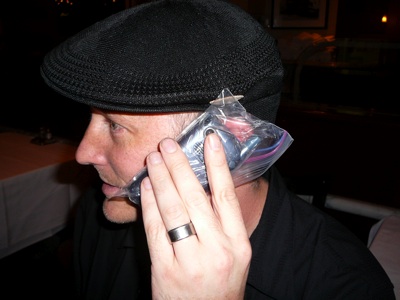
It does look pretty dorky. Anyone else have the same problem, or different solution?


